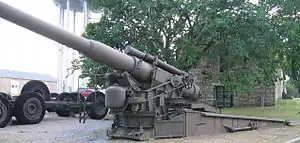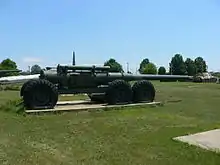8-inch gun M1
The 8-inch gun M1 was a 203 mm towed heavy gun developed in the United States. At 32,584 m (35,635 yd), it had the longest range of any US Army field artillery weapon in World War II. It was also used in small numbers by the British Army.
| 8-inch gun M1 | |
|---|---|
 | |
| Type | Heavy gun |
| Place of origin | United States |
| Service history | |
| Used by | United States United Kingdom |
| Wars | World War II |
| Production history | |
| Designed | 1939–1942 |
| Produced | 1942–1945 |
| Specifications | |
| Mass | Combat: 69,300 lb (31,400 kg) |
| Barrel length | 33 ft 4 in (10.16 m) L/50 |
| Shell | separate-loading, bagged charge |
| Caliber | 203 mm (8.0 in) |
| Breech | Interrupted screw |
| Recoil | Hydro-pneumatic |
| Carriage | Split trail |
| Elevation | +10° to +50° |
| Traverse | 30° (initially), post-war 40° |
| Muzzle velocity | 2,840 ft/s (870 m/s) |
| Effective firing range | 12.5 mi (20.1 km) (minimum) |
| Maximum firing range | 20.24 mi (32.57 km) |
Development and production

In 1919, the Westervelt Board described the ideal heavy gun for future development having a bore of 194 mm to 8 inches, a projectile of about 200 lbs in weight, and a range of 35,000 yards. More striking was the requirement that it be road transportable. At this time no other country had such a road-transportable field gun.[1] Low-priority design work occurred until 1924. Serious development began in June 1940 of an 8-inch (203 mm) gun that would have a range of 33,500 yards (30,600 m), a road speed of 25 mph (40 km/h), be transported in two loads weighing no more than 44,000 lb (20,000 kg) and be suitable for rail movement. The gun used the same projectile as the 8-inch coastal gun and the US Navy's 8-inch cruiser gun.[2] Using the same carriage as the 240 mm howitzer M1 eased development, but the gun was very troublesome and was not standardized until January 1942. The main problems were excessive bore wear and poor accuracy, but it was felt that nothing better could be produced in a timely manner. Thus it entered production at a low rate and in small numbers. The gun tube was produced by Watervliet Arsenal, and the recoil system was produced by Hannifin Manufacturing. Watertown Arsenal, Bucyrus-Erie, and the S. Morgan Smith Company manufactured the carriage. Only 139 weapon systems were produced before production ceased in 1945.[3]
In the quest for greater tactical mobility, the Ordnance Department experimented with a self-propelled version. Like the 240 mm howitzer, it was mounted on a stretched Heavy Tank T26E3 chassis that had an extra bogie wheel per side as the 8in Gun Motor Carriage T93, but the war ended before they could be used, and they were later scrapped.
Transport

One of the requirements during development was that the gun be easy to emplace. Given the weight of the gun and carriage, this was a challenge. Eventually, a pair of three-axle, six-wheeled transport wagons were developed – one for the barrel and recoil mechanism, and one for the carriage. These transport wagons were also used with the 240 mm howitzer. These were standardized as the M2 and M3. The M2 wagon carried the carriage and the M3 wagon carried the barrel and recoil system as shown to the left. This separate configuration required the use of the 20-ton M2 truck-mounted crane for setup. The crane also included a clam-shell bucket that was transported on a trailer and used to dig the recoil pit for the gun. In spite of the weight and being transported in two pieces, the gun could be emplaced in as little as two hours.[4]
The transport wagons were initially intended to be towed by the Mack NO 7 1⁄2-ton heavy truck, but as a wheeled vehicle it had problems in soft ground. The M6 High Speed Tractor which was explicitly designed for towing the 8-inch gun and 240 mm howitzer was not yet in production, so the Ordnance Department improvised in the meantime. M3 Lee medium tanks and M10 tank destroyers were quickly modified and tested. These proved to be satisfactory and were adopted for use as the M33 and M35, respectively.[2]
Variants
- 8in Gun Motor Carriage T93 - prototype
Service
The gun was assigned to non-divisional battalions, eight of which were eventually organized, trained and equipped. Each consisted of six guns, organized into three batteries of two gun sections each. Five battalions saw service in Europe or Italy (153rd, 243rd, 256th, 268th, and 575th) and three in the Pacific (570th, 573rd, and 780th).[5] They first saw action in Italy in April 1944 at the Anzio beachhead when Battery B of the 575th Field Artillery Battalion was attached to the 698th Field Artillery Battalion.[6] Battery A of the 575th also went to the Cassino front attached to the 697th Field Artillery Battalion, and was used in the counter-battery role against long-range German 170 mm guns. By September 1944, the 8-inch guns of the 575th had been withdrawn from Italy, and soon saw action in Europe where they were particularly effective against fortified targets and in counter-battery fire against German long-range artillery. At St. Malo, France, two battalions of 8-inch guns participated in the siege. The 8-inch guns scored direct hits on the walls of the ancient citadel.[7] In the Siegfried Line campaign, the 8-inch guns, adjusted by aerial observers, knocked out two bridges over the Roer River.[7] At the end of the war, the battalions were deactivated and the guns moved into storage; however, they were never again used in action and eventually disposed.
Seventeen guns were supplied to Great Britain.[8]
Ammunition
The gun fired separate loading ammunition with two increments. M9 Green Bag propellant was used for medium ranges and was preferred for improved accuracy and reduced barrel erosion. M10 White Bag was used for long- and extreme-range firing. Only two fuses were used: M51A3 point detonating (and delay), and M67A3 mechanical time. Range and muzzle velocity below are for maximum charge of M10 White Bag.
| Propelling Charges[9] | ||
|---|---|---|
| Model | Weight | Components |
| M9 | 34.47 kg
(76 lb) |
Base charge and one increment |
| M10 | 48.12 kg
(106.1 lb) |
Base charge and one increment |
| Projectiles[9] | |||||
|---|---|---|---|---|---|
| Type | Model | Weight | Filler | Muzzle Velocity | Range |
| HE | HE M103 Shell | 108.86 kg
(240 lbs) |
TNT, 9.52 kg
(21 lbs) |
868 m/s
(2,850 ft/s) |
32,584 m
(35,635 yd) |
| Drill | Dummy M13 | 108.86 kg
(240 lbs) |
|||
Existing examples
Only three examples are known to have survived. They are located at:
- 45th Infantry Division Museum, Oklahoma City, Oklahoma
- US Army Artillery Museum, Fort Sill, Oklahoma
- US Army Ordnance Museum, Fort Lee, Virginia
See also
References
- A Board of Officers (1919). The Report of the Westervelt Board. Morris Swett Library: The War Department. p. 30.
- F., Schreier, Konrad (1994). Standard guide to U.S. World War II tanks & artillery. Krause Publications. p. 104. ISBN 0873412974. OCLC 31007442.
- Williford, Glen M. (2016). American breechloading mobile artillery 1875-1953 : an illustrated identification guide. Schiffer Publishing Ltd. p. 176. ISBN 9780764350498. OCLC 927401960.
- Steve., Zaloga (2007). U S field artillery of World War II. Osprey Pub. p. 34. ISBN 9781846030611. OCLC 123895340.
- 1948-, Stanton, Shelby L. (1984). Order of battle, U.S. Army, World War II. Presidio. pp. 401, 404, 405, 414. ISBN 978-0891411956. OCLC 10727063.CS1 maint: numeric names: authors list (link)
- Williams, Captain Colin J. (July–August 2003). "Saved by Artillery: How MG Lucas Lost the Initiative at Anzio and the Allied Artillery Regained It". Field Artillery Journal.
- Mayo, Lida (1991). The Ordnance Department: On Beachhead and Battlefron. Washington, DC: Center of Military History United States Army. pp. 266–267, 326.
- Steve., Zaloga (2007). U S field artillery of World War II. Osprey Pub. p. 37. ISBN 9781846030611. OCLC 123895340.
- Technical Manual TM9-1901 Artillery Ammunition. War Department. 1944. pp. 312–313, 206–207, 376.
Bibliography
- Hogg, Ian V. (1998). Allied Artillery of World War Two. Greenhill Books. ISBN 1-85367-478-8.
- Hogg, Ian V. The Guns, 1939-45. New York: Ballantine Books, 1970 ISBN 0019067100
- Schreier Jr., Konrad F. – Standard guide to U.S. World War II Tanks & Artillery (1994) Krause Publications, ISBN 0-87341-297-4.
- Williford, Glen M (2016). American Breechloading Mobile Artillery 1875-1953. Thomas D. Batha. Schiffer Publishing Ltd. ISBN 978-0-7643-5049-8.
- Zaloga, Steven J. (2007). US Field Artillery of World War II. New Vanguard 131. illustrated by Brian Delf. Osprey Publishing. ISBN 978-1-84603-061-1.
- Technical Manual TM9-2300 Standard Artillery and fire Control Material. (dated February 1944)
- Technical Manual TM9-336 8-inch Gun M1 and Carriage M2. War Dept. Nov. 1943
- Field Manual FM6-95 Service of the Piece 8-Inch Gun M! and 240-MM Howitzer M1. War Department. Feb 1946
External links
| Wikimedia Commons has media related to 8in Gun M1. |
- British Artillery in World War II
- United States. War Dept.. Service of the piece, 8-inch gun M1 and 240-MM howitzer M1.. Washington, D.C.. UNT Digital Library. Retrieved on 2012-08-17.